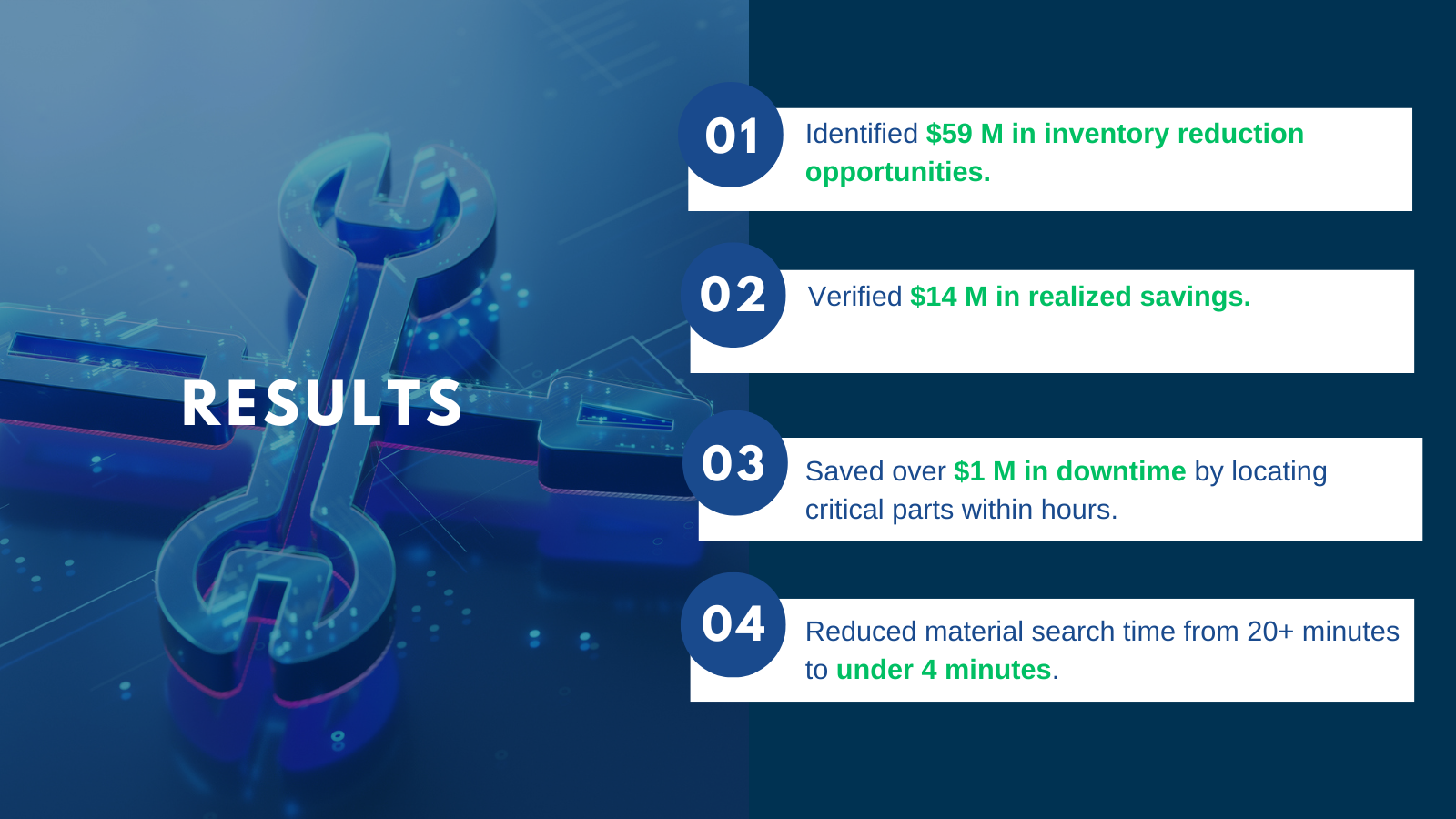Optimizing MRO Inventory Strategies to Reduce Supply Chain Risk

For global manufacturers, the real supply chain risks often begin inside the plant – in the storeroom, in the material master, and across disconnected ERP systems.
When Maintenance, Repair, and Operations (MRO) inventory isn’t optimized, the consequences ripple far beyond maintenance: unnecessary downtime, inflated working capital, and poor visibility into what’s actually available.
In today’s volatile supply chain environment, optimizing MRO inventory is one of the most powerful levers for reducing risk and ensuring business continuity.
The Risk Hidden in MRO Inventory
MRO inventory typically represents less than 10 percent of a company’s total spend – yet it accounts for the majority of supply chain disruptions.
Here’s why:
- Poor data quality: Duplicate and inaccurate material records cause delayed maintenance and overbuying.
- Siloed systems: Different ERPs and plants manage inventory independently, creating gaps and redundancies.
- Reactive maintenance: Without visibility, teams overstock to protect against uncertainty.
- Fragmented suppliers: No unified view of supplier reliability or lead time risk.
When multiplied across dozens of sites, these inefficiencies trap millions of dollars in idle inventory while increasing the risk of downtime when critical materials can’t be located quickly.
Turning MRO Data into Risk Intelligence
Most manufacturers treat MRO optimization as a cost-control exercise. But with AI-powered visibility, it becomes a risk-reduction strategy that safeguards uptime, procurement performance, and working capital.
Modern MRO inventory optimization platforms transform fragmented data into actionable intelligence through:
- AI-driven material matching: Identifying duplicate and equivalent items across ERP systems.
- Network-level visibility: Seeing material availability across every site and supplier.
- Predictive insights: Anticipating which materials are at risk of stockout or obsolescence.
- Continuous monitoring: Tracking data accuracy, supplier lead times, and part reliability.
This visibility allows operations, procurement, and finance teams to collaborate on proactive decisions – reducing uncertainty and strengthening supply chain resilience.
Financial and Operational Impact of Optimized MRO
For large manufacturers with $100 M+ in MRO inventory, even small improvements have massive impact:
- 10–20 percent inventory reduction = $10–$20 M in freed working capital.
- 25 percent carrying cost reduction = $2.5–$5 M in annual savings.
- Improved uptime reliability = millions saved in avoided production losses.
Optimization reduces both financial and operational risk – stabilizing supply continuity and ensuring critical materials are available where and when they’re needed.

Case Study: Fortune 500 Packaging Manufacturer Reduces Risk Through Visibility
A Fortune 500 packaging manufacturer faced a growing problem: inconsistent MRO data across multiple ERPs after years of acquisitions. The result was excess inventory, frequent stockouts, and wasted working capital.
The Challenge
- Poor visibility across sites.
- Duplicate material records and inaccurate data.
- Maintenance delays due to missing or mislabeled parts.
The Solution
The company implemented Verusen’s AI-driven MRO inventory optimization platform, connecting all systems into a single, accurate source of truth. The platform identified duplication, standardized data, and surfaced materials at risk of shortage – helping maintenance teams act before downtime occurred.

The Outcome
The manufacturer achieved faster decision-making, reduced maintenance risk, and built a resilient MRO supply chain capable of responding to disruption with agility and confidence.
How MRO Optimization Strengthens Supply Chain Resilience
MRO optimization is no longer about tightening budgets – it’s about building resilience and agility. By turning static data into dynamic intelligence, manufacturers gain:
- Real-time visibility across all materials and sites.
- Predictive maintenance alignment to prevent downtime.
- Supplier performance insights to mitigate procurement risk.
- Cross-functional collaboration between operations, procurement, and finance.
When MRO data is connected and intelligent, disruptions become predictable – and avoidable.
FAQs
How does MRO optimization help reduce supply chain risk?
By centralizing data and visibility, companies can identify at-risk materials, optimize stocking levels, and respond to supply disruptions before they impact production.
Can Verusen’s platform integrate with multiple ERP systems?
Yes. Verusen connects directly with SAP, Oracle, Maximo, and Infor systems, harmonizing data without requiring migration or downtime.
How quickly can results be achieved?
Most manufacturers realize improved visibility and measurable savings within 8–12 weeks, with full optimization typically achieved in 6–12 months.
What measurable ROI can be expected?
Verusen customers typically identify 10–25 percent in inventory reduction and free millions in working capital, while strengthening maintenance reliability and supplier performance.
The most advanced manufacturers don’t just respond to disruption – they prevent it.
By optimizing MRO inventory, they transform maintenance operations from a vulnerability into a strategic defense against supply chain risk. Verusen helps global manufacturers unify their MRO data and strengthen operational resilience.
Schedule an MRO Risk Reduction Assessment today to see how AI can future-proof your supply chain.
